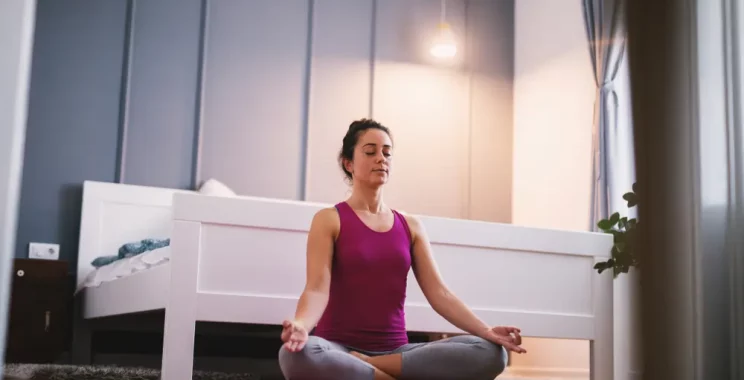Yoga For Better Sleep
Share
Fact checked
Reviewed by experts
Updated
January 6, 2023
Quick read
5 mins to read
List of Content
You toss and turn, but your mind is on overdrive. You try to think of something pleasant, and nothing seems to help. You know you need these precious hours because it’s a big day tomorrow and the frustration rises. Yes, some nights can be restless ones. This is when you need yoga for sleep. These easy stretches can help relax your body and calm your mind so you can embark on a peaceful sleep journey. How to incorporate yoga for sleep? Read ahead to know all about it.
Utthan Pristhasana (Lizard Pose)
- Start with a downward-facing dog position.
- Now, keep your right foot on the outside of your right hand. Here, the toes must align with the fingers, and the right knee must be at a 90-degree angle.
- Next, keep your elbows on the floor and ensure your forearms are straight.
- You must keep your head in a relaxed position.
- After a few deep breaths, release and return to the downward-facing dog position.
Salabhasana (Locust Pose)
- First, lay down on your stomach and place your arms at the sides.
- Stretch your legs, so your toes are pointed, and keep them slightly apart.
- Now, raise your head and look forward.
- Finally, lift your chest slightly, put your hands on your sides, forming a line, and try to raise them. Next, lift your legs slightly towards the ceiling.
- Hold it for a minute, and then release it.
Uttanasana (Standing Forward Bend)
- Stand straight with your feet together.
- Slightly bend your knees and bend down.
- Place your hands on the floor or next to your feet.
- Now take a deep breath and let the chest stretch the spine.
- Stay in the position for a minute or two and take deep breaths. Finally, relax and slowly come back up.
Prasarita Padottanasana (Wide-Legged Standing Forward Bend)
- Stand on your mat and keep your feet 3 to 4 feet apart from each other.
- Now, fold your torso over the legs. But don’t bend your lower back, instead, bend the hips joints slightly.
- Next, place your hands on the floor and stretch forward.
- Make sure you lengthen your entire spine and take deep breaths.
- Finally, come back up slowly.
Janu Sirsasana (Head-of-the-Knee Pose)
- Sit on your mat with your leg outstretched.
- Now, bending the knees place the right foot on the left inner thigh.
- Next, bend forward and hold your foot with your hands.
- Make sure you keep the spine long.
- Stay in this position for a bit and then release.
Paschimottanasana (Seated Forward Bend)
- Keep a folded blanket and the top of the map and sit on its edge.
- Now stretch your legs forward.
- Now bend your torso forward so your spine is straight.
- Make sure you push forward until your hands can touch the toes.
- Stay in the position for a bit and release.
Supta Baddha Konasana (Reclining Bound Angle Pose)
- Lay down on the floor and relax your body.
- Now, join your left foot with the right and lift the legs up towards the torso.
- Keep your hands on the side.
- Keeping the feet joint, bring your legs down and widen your outer knees, almost forming a sort of triangle.
Stay in this position for a bit and take deep breaths and then release.
Parsva Upavistha Konasana (Side Seated Wide Angle Pose)
- Sit in a staff position and make sure you spread your legs wide. But be comfortable.
- Now, twist from the waist and face towards your right leg.
- Next, move your hands towards the right foot and touch the knees to the forehead. Hold the position for a few seconds.
- Repeat the same on the other side.
Supta Virasana (Reclining Hero Pose)
- First, start with a virasana where you sit on your heels.
- Now, place your hands on the mat.
- Next, make sure you press the top of the feet to the mat.
- Then lower your back slowly so it touches the mat.
Keep your hands on the sides and stay in this position for a bit and then release.
Supta Padangusthasana (Reclining Hand-to-Big Toe Pose)
- Lie flat on your back and then bring your knees to the chest.
- Straighten your left leg and lay it flat on the mat.
- Now, straighten your toes and point them upwards.
- Finally, walk your hands up and take hold of the hack of your thighs. But if you can reach, go towards your knees or even ankles.
- Finally relax and bring your legs down. Repeat it with the other side.
Setu Bandha Sarvangasana (Bridge Pose)
- First, lie on your back and then bend your knees. Here, your knees should be pointed upwards.
- Keep your arms next to your body and then spread your feet.
- Now, put all the power on your feet and hands and put your back upwards while your head still touches the mat.
- Make sure your chin is tucking in and try to lift your hips even higher.
Viparita Karani (Legs-up-the-Wall Pose)
- Make sure there is a wall to support the right side. While still sitting, bend your knees and bring the feet towards the hips.
- While your knees are still bent, lie down on your back.
- Now swing your legs upwards and if you need support, use the wall.
- Stay in this position for a few minutes and then release.
Siddhasana, variation (Adept’s Pose, variation)
- First, relax and sit on the mat.
- Now bend your left knee and move your heel towards the groin, next to the right inner thigh. Keep the left knee on the ground.
- Next, bend your right knee and place your right heel over the left.
- Finally, tuck the edge of your foot near the space between the left thigh and the calf. Here, make sure you sit absolutely straight.
- Stay in this position for some time and then release.
Sukhasana (Easy Pose)
- Sit in a comfortable, cross-legged position.
- Ensure your hips align with your shoulders.
- You can keep your hands on the lap or on top of the thighs.
- Keep your spine straight and take deep breaths.
Savasana (Corpse Pose)
- Lie down on your back and spread your leg slightly to practice this 10-minute yoga before bed.
- Place your arms on your side but slightly away from your torso.
- Now, relax your body and take deep breaths.
Yoga to do before bed can be extremely beneficial. Try these yoga poses before bed to help you relax.
Benefits Of Bedtime Yoga Routine
Some of the benefits of bedtime yoga are given below.
Alleviates insomnia
Yoga can be an excellent treatment to manage insomnia. Practicing yoga for insomnia helps you fall asleep for longer time. One study showcased the benefits of yoga for insomnia. While people who practice yoga regularly swear by the improvements in their sleep patterns, further research is still necessary. How does yoga improve sleep? By relaxing you!
Weight loss
If hitting the gym isn’t your cup of tea, yoga can help shed those few extra pounds. Consistent practice of nighttime yoga can lead to weight loss. In fact, when you practice yoga right before bed, it can help you sleep well and manage your symptoms better.
Improves sleep quality and life quality
Yoga is a boon that can be enjoyed in the comforts of our homes, and even try yoga in bed. It can be a great alternative to sleeping pills. As per one study, practicing yoga positively affected older adults by helping with their sleep and enhancing their overall health.
Promotes relaxation
Yoga for sleep can be truly beneficial when thoughts are racing your mind and anxiety grips you. There are a few yoga routines that can relax you completely.
Things to Remember While Doing Bedtime Yoga
- Always do complete research before practicing. If you can, find a yoga teacher.
- Don’t start with complicated evening yoga poses. Start with something easy.
- Be patient when practicing yoga, as it will take some time to see visible results.
- Always wear comfortable clothing when practicing yoga.
- Always practice on a yoga mat.
- Don’t perform yoga stretches before bed. Do it at least an hour or two before.
- Focus on your breathing while doing yoga.
Remember, practice makes you perfect.
Conclusion
If you are unable to sleep quickly, yoga can be a boon. The above-mentioned yoga positions are easy to perform, and you can do them daily without any hassles. Do it for just 10 to 20 minutes to avail its benefits.
FAQs
Yes, yoga can help you fall asleep. Take a look at the yoga poses mentioned in the above articles as they can help you sleep. They are not difficult to follow.
Try to practice yoga 30 minutes to an hour before bed at least. This will help you relax and fall asleep easily. Yoga is also a form of exercise, so practicing exactly a minute or so before bed can supply you with unwanted energy.
If you are wondering which yoga is best for sleeping then take a look at the above article where we bring you several yoga poses to help you out. Always start with the easiest.
This website does not offer medical advice nor professional medical services; rather, it is provided solely for educational, informational, and/or entertainment purposes. Individuals seeking medical advice should consult a licensed physician. The information provided should not be used for diagnosis or treatment of any condition, disease, or injury. When you have a medical condition, you should always talk to licensed doctor or other certified medical professional. You should never delay seeking professional medical advice or treatment based on the contents of this website. Call 911 or immediately go to the nearest emergency room if you think you may have a medical emergency. The contents of this website are provided “as-is”, Sleep Authority and its parent, subsidiaries, affiliates, employees, contributors disclaim any warranty of the information contained herein. Please contact using contact form to report any errors, omissions, misinformation, or abuse.
Sleep Authority is brought to you by Resident, the company that brings you Nectar, DreamCloud, Awara, Wovenly, Bundle, Home Well Designed and Level Sleep.



